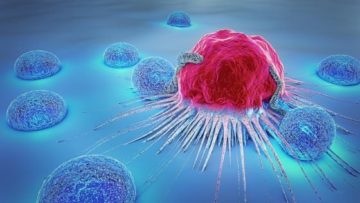by Kenneth J. Pienta
 No metaphor for cancer does it justice. As a medical oncologist and cancer researcher, I struggle constantly with how people perceive cancer. Until a person suffers from it or sees a loved one suffer from the devastation of this disease, cancer remains an abstract term or concept. But it is an abstract concept that kills 10 million people around the world every year. Ten million people every year. How do we get people to understand that this is a lethal disease that deserves attention. That deserves more funding. That deserves more minds thinking about how to stop the continual suffering that metastatic cancer causes.
No metaphor for cancer does it justice. As a medical oncologist and cancer researcher, I struggle constantly with how people perceive cancer. Until a person suffers from it or sees a loved one suffer from the devastation of this disease, cancer remains an abstract term or concept. But it is an abstract concept that kills 10 million people around the world every year. Ten million people every year. How do we get people to understand that this is a lethal disease that deserves attention. That deserves more funding. That deserves more minds thinking about how to stop the continual suffering that metastatic cancer causes.
I believe that part of the problem stems from the fact that we have no adequate way to communicate the suffering that cancer causes. It remains too abstract. We have used analogies to explain cancer that make the disease more palatable than it should be.
Cancer researchers often describe cancer as a “wound that does not heal”. This analogy was first forth by Harold Dvorak in 1986 because tumors grow and remodel the organ they are growing in much like wounded skin does. Similarities between tumor stroma generation and wound healing.[i] The difference is that a normal wound scars over and cancer simply does not. Tumors do not have a negative feedback growth loop that says to stop growing and scar over. Cancer just keeps growing.
Medical oncologists often use the analogy of a car that has lost control of its accelerator and brakes to describe cancer. Cancer cells can be thought of as a car without brakes that continues to accelerate and become more dangerous. Just as a car can crash into other cars or obstacles, cancer cells can invade and damage nearby tissues and organs or spread to other parts of the body (the process of metastasis). The problem with this analogy is that we tend to think of broken cars as things that can be fixed. While we can slow metastatic cancer down, we cannot fix it. Metastatic cancer is lethal. It is a car crash that can’t be walked away from.
Because cancer destroys the normal tissues and organs, metaphors that use ecologic terms are also often used to describe cancer by cancer researchers as well as the lay public. We talk about the cancer destroying the organ “ecosystem”, the “tumor microenvironment”, and the cancer “evolving” over time.[ii] Use of these eco-evolutionary terms promotes analogies to ecosystems we tend to see every day – the environment around us. The analogy of the human species becoming a cancer on the planet is generally attributed to Warren M. Hern, a physician at the University of Colorado who wrote an article describing the similarities between cancer and humanity (Hern WM. Has the human species become a cancer on the planet? A theoretical view of population growth as a sign of pathology.[iii] To quote directly from his paper: “the human species as a whole now displays all four major characteristics of a malignant process: rapid, uncontrolled growth; invasion and destruction of adjacent normal tissues (ecosystems); metastasis (distant colonization); and dedifferentiation (loss of distinctiveness in individual components). We have become a malignant ecopathologic process”. Over the last three decades, this metaphor has been used to describe the negative impact of human activities on the environment. Conversely, it has also been used to explain how cancer grows in a primary organ and the spreads throughout the body, destroying organs and tissues where it grows.
The ecologic analogy does not do justice for either humanity or cancer. Hern also states in that first article: “The difference between us and most forms of cancer is that we can think, and we can decide not to be a cancer.” The metaphor suggests that humans, like cancer cells, are rapidly multiplying and consuming resources without regard for the long-term consequences, leading to the destruction of the planet’s ecosystems. It is true that human activities have caused significant damage to the environment and have negatively impacted many species and ecosystems. We see this every day in the news, from destruction of the Amazon rain forest to the melting glaciers to draughts around the world. But we also know that we can think and we can change and we can make positive impact. Not all human activity is destructive and many people are aware of the damage we are doing to the planet and actively engaging in more sustainable and environmentally-friendly practices. This analogy does not fit with who we are as a race, and it certainly takes away understanding what cancer really is and what it does to a person.
On the other hand, Hern also notes that we, as humans, can think. One of the biggest mistakes we make in trying to understand cancer is that we anthropomorphize it – we endow it with human properties and the capacity to think. Cancer does not think. Metastatic cancer – cancer that spreads and leaves the primary site -is a scourge to people, a lethal disease that almost always destroys the body. Cancer cells multiply rapidly, destroying the primary organ they originate in and at the same time, spreading to other parts of the body, causing damage and wreaking havoc in whatever organ they start to grow in. But is not a conscious process. This is very difficult for us as humans to understand. We are not used to thinking of processes that we see in the natural world as happening without purpose. The world we live in and understand is built on homeostasis – there are rules and feedback loops in place to control virtually every part of our existence. These controls are part of our daily lives and make life understandable and society function. Cancer, however, does not follow normal rules. Cancer destroys the body because it is not controlled by any feedback loops. Nothing stops cancer cells from proliferating, spreading, and producing poisons that destroy the body.[iv] The lethal phenotype of cancer: the molecular basis of death due to malignancy.[v] In addition, the cancer cells (as well as the host reaction to them), produce “poisons” that make the suffering person sicker, leading to phenomenon such as cancer cachexia. Metastatic cancer is a near-universally destructive and fatal disease. We need to understand that. By using it as an analogy in any form takes away from how serious, destructive, and incurable it is.
The most common metaphor related to cancer, however, is describing our quest for better treatments and cures as a “war”. President Richard Nixon signed the National Cancer Act on December 23, 1971 and started the war on cancer. Ever since, the public has heard about progress we make in cancer research and treatment in terms of winning the war. The war analogy portrays cancer as an enemy to be fought and conquered, with the patient as a warrior battling a disease. This analogy can be empowering and motivational, but it can also create a sense of blame or guilt if the patient’s cancer progresses or doesn’t respond to treatment. And metastatic cancer virtually always progresses and kills the patient. As a medical oncologist, I have seen first-hand the devastation that a patient and their family feels because they “did not fight hard enough”.
The war analogy also misleads the public. Cancer is not a single enemy that can be defeated with a single battle or campaign. Instead, cancer is a complex disease that can vary widely from person to person, even within the same type of cancer. Metastatic cancer is not an intentional enemy with a conscious goal. It is simply a result of the body’s own cells growing and dividing and spreading uncontrollably. The new Cancer Moonshot program suffers from the same analogy problem. While we need more cancer research funding, it is misleading to describe the program in terms that make solving cancer a simple engineering problem with a straightforward solution that can be reached with enough resources. Framing cancer as a war to be won or lost, or as a simple goal of getting to the moon, deemphasizes how deadly metastatic cancer continues to be.
Cancer continues to kill 10 million people around the world every year. We need to acknowledge that we do not yet understand how cancer forms and why metastatic cancer continues to be incurable and lethal. Analogies, metaphors, and comparisons that anthropomorphize the disease take away from the serious fact that we still do not know how to cure metastatic cancer. There is much work to be done. Let’s be uncomfortable.
***
 Dr. Ken Pienta is a medical oncologist and physician scientist who applies ecological principles to drive discovery as well as take care of patients. Currently, Ken is the Donald S. Coffey Professor of Urology, Oncology, Pharmacology and Molecular Sciences, and Chemical and Biomolecular Engineering at the Johns Hopkins School of Medicine. He is Director of Research at the Brady Urological Institute and co-Director of the Cancer Ecology Center at Johns Hopkins. For the last 30 years, Ken has specialized in taking care of men with prostate cancer, delivering personalized care to thousands of men as well as designing and conducting clinical trials to improve the quality of life and survival of patients with cancer. Ken is an advocate of multidisciplinary care of patients as well as multidisciplinary team research to advance science to the clinic. He is tired of losing.
Dr. Ken Pienta is a medical oncologist and physician scientist who applies ecological principles to drive discovery as well as take care of patients. Currently, Ken is the Donald S. Coffey Professor of Urology, Oncology, Pharmacology and Molecular Sciences, and Chemical and Biomolecular Engineering at the Johns Hopkins School of Medicine. He is Director of Research at the Brady Urological Institute and co-Director of the Cancer Ecology Center at Johns Hopkins. For the last 30 years, Ken has specialized in taking care of men with prostate cancer, delivering personalized care to thousands of men as well as designing and conducting clinical trials to improve the quality of life and survival of patients with cancer. Ken is an advocate of multidisciplinary care of patients as well as multidisciplinary team research to advance science to the clinic. He is tired of losing.
***
[i] N Engl J Med. 1986 Dec 25;315(26):1650-9. PMID: 3537791.
[ii] Amend SR, Pienta KJ. Ecology meets cancer biology: the cancer swamp promotes the lethal cancer phenotype. Oncotarget. 2015; 6(12): 9669-78. PMID: 25895024
[iii] Curr World Lead. 1993 Dec;36(6):1,089-124. PMID: 12291996
[iv] Loberg RD, Bradley DA, Tomlins SA, Chinnaiyan AM, Pienta KJ
[v] CA Cancer J Clin. 2007 Jul-Aug;57(4):225-41. PMID: 17626119
